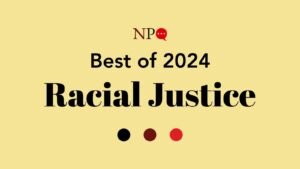

“It’s our job somehow to graft a conscience on the capitalist.”
Chuck Matthei, CDFI movement cofounder, 1985
Last month, the Opportunity Finance Network (OFN), the nation’s leading community development financial institution (CDFI) trade association, held its first in-person national conference in three years in New York City. It was a sold-out affair, attracting a record attendance of over 2,000 people.
For CDFIs, these are heady days. Once, CDFIs were obscure; today, while still small compared to the $22 trillion banking sector, CDFIs are significant financial players.
The transformation is obvious. OFN’s 2022-2024 strategic plan, released shortly before the conference, begins by recalling that when the late Chuck Matthei spoke at the organization’s first conference, 65 people attended, representing 47 loan funds whose combined assets totaled $27 million. Today, member loan funds’ asset holdings are over 1,000 times greater.
All told, CDFIs—including not just loan funds, but also community development credit unions, banks, bank holding companies, and venture funds—have $266 billion in assets, according to a 2020 study from the US Social Investment Forum. This number is sure to rise when new data are announced this December.
OFN’s strategic plan speaks to the extraordinary pace of change. In it, a provision indicates that at least 40 percent of loans made by OFN to support its members should be set aside for smaller CDFIs, defined as funds with less than $25 million in assets. In other words, a single “small” CDFI today might be nearly as large as all CDFI loan funds combined in the mid-1980s.
CDFIs have been growing rapidly for decades. Key moments include the passage of the CDFI Act in 1994, which created a small program at the US Department of Treasury (initial funding was $50 million) to provide equity grants to qualifying institutions. Shortly afterward, as Beth Lipson, chief financial officer (and interim CEO) of OFN, pointed out, federal regulators decided that bank support of CDFIs (via loans or grants) would “count” toward meeting banks’ federal Community Reinvestment Act (CRA) obligations, which made bank capital another leading source of sector growth.
More recently, as NPQ has covered, CDFIs’ role in keeping businesses afloat during the COVID-induced economic shutdown, especially in BIPOC communities, has increased their prominence. In its crucial first $349-billion round, the Paycheck Protection Program (PPP) largely bypassed BIPOC-owned businesses in low-wealth communities. To address this omission, Congress explicitly included CDFIs in its legislation authorizing a second PPP round, helping such institutions to funnel $34 billion to businesses. Recognizing the valuable role CDFIs had played, in December 2020, Congress awarded $12 billion to CDFIs and minority depository institutions, an unprecedented amount that was more than 40 times as large as a typical CDFI Fund appropriation.
And yet, even as CDFIs gain both assets and status, they also face mounting obstacles. As the OFN strategic plan points out, “Over the past decade in America, we’ve seen the wealth gap widen, political and social divisions intensify, climate change accelerate, a pandemic wreak havoc on families and communities, and a racial reckoning take root.” In short, the CDFI mission of aligning capital with justice has proven elusive. Put simply, CDFIs have more resources, but they also face an ever more challenging environment.
Invest in change
“Invest in Change” was the name of the conference—it is also the title of OFN’s most recent strategic plan. But there is some tension inherent in the phrase.
Sign up for our free newsletters
Subscribe to NPQ's newsletters to have our top stories delivered directly to your inbox.
By signing up, you agree to our privacy policy and terms of use, and to receive messages from NPQ and our partners.
Does “invest in change” merely mean that CDFIs need more resources? In other words, is the phrase a call for government—and corporate donors and foundations—to invest in CDFIs? Or should the theme be interpreted as a call for the sector to invest in changing itself?
OFN’s strategic plan suggests that the plan’s authors have largely the former in mind. The goals set forth are organized into four main themes: money, strength, voice, and operations. With a few exceptions—the voice section, for example, makes nods to coalition building with civil rights and antipoverty groups and expresses support for broad federal policies to advance racial and economic justice—the objectives are largely quantitative: raise more grant and loan capital and increase direct lending to members; expand membership; advocate to boost federal support of the CDFI Fund from the fiscal-year 2022 level of $295 million to $1 billion a year; and grow the number and diversity of OFN staff.
The first plenary—which featured representatives from corporate donors, such as Citi, Bank of America, Nextdoor, and PayPal—echoed this theme. Panelists discussed how to increase corporate foundation support for CDFIs. Brandee McHale, president of the Citi Foundation, acknowledged that many in the community economic development field were skeptical of corporate commitments and that follow through was needed on racial equity commitments that her foundation and other corporate foundations had made.
She pointed to the White House-backed Equitable Opportunity Coalition, announced by Vice President Kamala Harris this past July, as a prominent public mechanism that could help “create a level of accountability” and peer pressure among corporate members. McHale also called for expanding the range of corporations that invest in CDFIs: “The CDFI sector has trailblazed new relationships in the tech sector,” McHale said, noting the presence on stage of tech industry supporters of CDFIs. She called on other corporations to likewise support CDFIs to enable them to better address pressing economic issues, such as poverty, housing, and food insecurity. “Where are consumer product companies? Where are the supermarket chains?” McHale asked. Again, McHale suggested that corporations that signed on to racial equity commitments ought to act to bring along additional corporate colleagues.
Is “more” enough?
There is no doubt that more resources are needed, but are more resources enough? Back in 2006, Mark Pinsky, then CEO of OFN, noted that community development finance was “winning important battles every day but we’re losing the war.” Changing that situation, he said, required a “structural and systemic” response to “fundamental, transformational changes in politics, demographics, and economics.”
He added that CDFIs were providing borrowers with “a little more than $9 billion in financing for housing, jobs, and community services” and needed to get to $45-90 billion a year. Fifteen years later, in fiscal year 2021, the federal CDFI Fund reported that in that one year, CDFI program awardees originated “loans or investments totaling more than $38.7 billion,” a figure that does not include investments originated by the hundreds of CDFIs that did not receive CDFI program awards that year. In short, the field has “scaled” in a significant way. Had it not, CDFIs would not have been positioned to respond to the COVID economic shutdown in the way they did. Even so, the dynamic that Pinsky observed 16 years ago persists.
Changing the dynamic
If growth is not enough, what is? Some breakout sessions explored this theme. At a panel on rural poverty, Dana Bezerra, president of the Heron Foundation, called for shifts of narrative and power. “We are solidly in the space between stories,” Bezzera remarked. “The old stories don’t work. They are broken. We need to put power in the hands of the people that are doing the work. We need a new story of risk and reward.” Bill Bynum, CEO of HOPE Community Credit Union, based in the Mississippi Delta, emphasized advocacy not just for CDFIs, but for the field: “The community needs strong advocates,” he said. Chrystel Cornelius, CEO of Oweesta, an organization that supports Native CDFIs, echoed Bynum: “We’re in corridors. We have the opportunity to speak to individuals that our communities never will.” Jim King, CEO of Fahe (formerly Federation of Appalachian Housing Enterprises), called on CDFIs to “think less of how we build our own balance sheet and think more about this as a movement.” Capital, he added, should be a tool that “fuels advocacy, narrative change, and building power.”
Another breakout session on urban small business development echoed similar themes from a community, rather than macro-level, perspective. Dianna Tremblay, chief program officer of the ICA (formerly Inner City Advisors)—a CDFI venture fund based in Oakland, California—said it was important to “take the ecosystem seriously;” cultivating connections among the businesses supported was as important as the capital itself. Lila Owens, an Oakland business owner and ICA borrower who started a cupcake business 15 years ago out of her kitchen and now operates seven storefronts that generate roughly $10 million in annual revenue, concurred, encouraging CDFIs to “emphasize the resources you provide that are not financial.”
Heather McGhee, author of The Sum of Us, was the featured speaker at the closing plenary. In her book, as NPQ has covered, McGhee emphasizes how racism has undermined (white) public support for infrastructure spending. As McGhee put it at the conference, racism has been “preying in the headwinds, holding us back.” Of course, the many groups being held back include the CDFI movement.
But McGhee closed on a positive note—calling attention to growing grassroots efforts and the potential to realize what she called the “solidarity dividend,” or the “gains that we can unlock when we come together across lines of race and recognize commons solutions to common problems.” For example, McGhee related that in Lewiston, Maine—a leading resettlement site for Somalian refugees—residents came together across racial lines to develop a whole new civic infrastructure that has “catalyzed an economic turnabout.” As a 2021 account which cites the Lewistown turnaround notes, quoting Catherine Besteman, an anthropology professor at Colby College who has written about Somali refugees in Maine, “Lisbon Street [the main street in Lewiston] had a lot of empty storefronts, and now it’s full of Somali cafes, translation agencies, [and] a mosque.”
Despite present-day backlash, McGhee said she was hopeful. “Our diversity,” she said, “can be our superpower, if we let it.” McGhee also saw potential for a broader economic shift if movement leaders seize the opportunity. Now, she observed, “is the moment when most people are looking for alternatives.” Increasing awareness of the possibility for a more democratic economy backed by community finance, she added, remains essential work.












